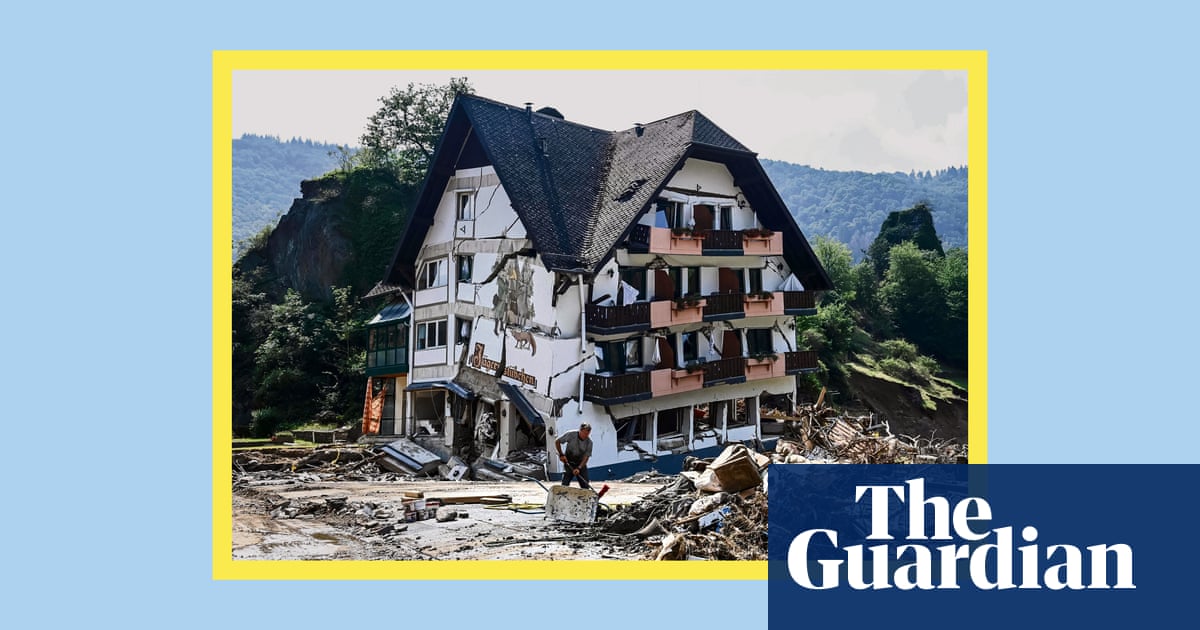This is an extract of this weekâs Down to Earth newsletter, to get more exclusive environmental journalism in your inbox every Thursday sign up here
Itâs common to think about the climate crisis as something that will happen in the future, in the global south.
But for several months Iâve been investigating the devastating impact of extreme flooding in Europe for my Guardian series The floods. What I saw, through my travels to Chesterfield, England, Germanyâs Ahr valley and Wallonia in Belgium, was that the climate emergency is in Europe, now. And itâs been happening for years.
Climate breakdown increases the risk of flooding, because hot air retains water, which increases precipitation. Climate scientists have found a 1C temperature increase means that 7% more water is retained in the air. The 2021 floods which devastated central Europe, specifically Belgium and Germany, were made more likely, some researchers think, by the climate crisis.
The aftermath was akin to a disaster movie. In the Ahr valley, a picturesque tourist region known for its hiking and pinot noir, the water level is believed to have reached up to 10 metres on the night of 14 July, 2021. The destruction was still clear to see. Mangled railway tracks loomed like twisted rollercoasters. Bridges were demolished by the force of the water. Entire houses were washed away with their inhabitants trapped inside.
And whatâs terrifying is that floods of that magnitude could happen again in central Europe â in fact, some scientists think they will happen once or twice before 2050. But the people are not prepared.
More on what I found, after this weekâs climate reads.
Essential reads
In focus
I arrived in Brussels on a frozen January afternoon. I was there for a sombre occasion: the memorial service for Rosa Reichel (pictured above), who died in the 2021 floods in Belgium. The service took place on what should have been Rosaâs 18th birthday. Instead, she was swept away by a flash flood while at a summer camp. I was there to meet her friend Benjamin Van Bunderen Robberechts, 17, who jumped into the water to try to save her, narrowly avoiding drowning himself. Now Benâs a climate activist, travelling the world to raise awareness of the climate emergency as part of his Climate Justice for Rosa campaign.
As I travelled through Belgiumâs Vesdre valley, I saw a community still reeling. Many had fallen victim to cowboy builders and were living in half-finished building sites, years on from the floods. Theyâd only been able to rebuild with the heroic efforts of unpaid volunteers. But alarmingly, people had rebuilt their homes almost exactly as before, without mitigation measures in place to protect them from future flooding. If the valley floods again, many of these homes will be destroyed â with further catastrophic loss of life.
In Germany, too, I saw similar short-termist thinking. Thereâs even a term for it: flood dementia. The idea that catastrophic flooding will not happen in the same place twice, even when the conditions for those floods â steep hillsides, communities built too close to the water, impermeable bedrock with limited opportunities for drainage â means that they probably will. Itâs a kind of magical thinking, and one that can prove fatal: in Germany, 188 people died in the 2021 floods. But in the Ahr, I also met two sisters and winemakers who were bucking the trend by relocating their vinery to the top of a hill, after narrowly escaping death during the floods.
And the UK is already seeing the fingerprints of climate breakdown in extreme weather events. In Chesterfield, I met the family of Maureen Gilbert, a beloved grandmother who died alone in her home during last Octoberâs Storm Babet. Since Babet, the UK has equalled its record for the most named storms during a storm season, with four months of the storm season left to go. March 2024 was the hottest recorded globally, and the 10th month in a row to break records.
Climate scientists have warned that we are entering unprecedented territory. As the world gets warmer, biblical flooding wonât be a one-off, exceptional event, but a new normal. We are not prepared.
Composted Reads
The good news
The bad news
The change I made â Growing my own salad
Down to Earth readers on the eco-friendly changes they made for the planet
after newsletter promotion
A simple tip this week from reader Lyn Wills, which benefits you and the planet: giving up plastic-wrapped salad leaves for some grown in your own garden.
âI started growing my own salad due to the abysmal quality and price of the salad bags in the supermarket, which go slimy a day or so after opening and often are very âstalkyâ,â says Wills.
You donât even need a big patch to make it work, Wills is quick to stress. âI have a very small space which is sunny enough and I just grow and pick what I need. This year I planted a tray each of lettuce and beetroots, instead of seeds, the rocket and chives come back every year. Itâs more foolproof than seeds but a bit more expensive.â
Let us know the positive change youâve made in your life by replying to this newsletter, or emailing us on [email protected]
Creature feature â Chimpanzee
Profiling the Earthâs most at-risk animals
Population: 175,000-300,000
Location: Forests of central Africa
Status: Endangered
Highly social animals who can live to be older than 50, chimps are our closest cousins â we share about 98% of our genes. Threats include poaching and habitat loss â exacerbated by a slow reproductive rate. Ecotourism initiatives in Africa aim to protect chimps from poaching by providing alternative incomes for communities.
For more on wildlife at threat, visit the Age of Extinction page here
Picture of the week
One image that sums up the week in environmental news
Itâs hard to pick just one photograph from this beautiful Guardian gallery celebrating âeco-brutalistâ architecture, but this shot of Parisâs dense but leafy Les EÌtoiles dâIvry housing block wins out.
Each of the 13 photographs in the piece, taken across the world from Brazil to Bosnia, feature in the new book Brutalist Plants by Olivia Broome. âBrutalism can be this quite harsh, austere architecture style, but with nature involved, it balances it all out,â she says.
For more of the weekâs best environmental pictures, catch up on The Week in Wildlife here



